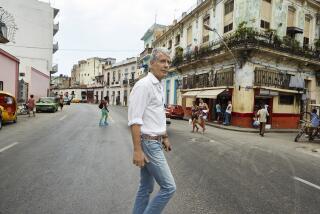Istanbul from the inside out
AFTER having published five novels in 20 years, the versatile Turkish writer Orhan Pamuk now presents “Istanbul: Memories and the City,” an engaging if curious grab bag of a book that is partly a memoir and partly a portrait of the place he has lived all his 50 years. Abounding with a deep affection for, and preoccupation with, his birthplace, Pamuk offers a kind of literary cabinet of curiosities that seeks, through miniaturist sketches, evocative asides and abundant atmospheric black-and-white photographs, to pay homage to a city that straddles East and West, past and present, remembered grandeur and formidable decay.
In “Istanbul,” he refers to an essay by critic and philosopher Walter Benjamin on writers’ descriptions of great cities. Benjamin divided them into two groups according to the birthplaces of the authors and found that those written by natives of the cities were few. “According to Benjamin,” Pamuk observes, “the enthusiasm for seeing a city from the outside is the exotic or the picturesque. For natives of a city, the connection is always mediated by memories.”
This may seem obvious, but it speaks to Pamuk’s particular mission -- and its challenges. Unlike outsiders who expose themselves to a city for a period, then act like curators, sorting and sifting what they discover until a clear-eyed, knowing, perhaps exotic or picturesque sort of book emerges (think of Mary McCarthy in Florence or Eleanor Clark in Rome), Pamuk, the quintessential insider, sometimes becomes lost in a loop of personal reflection and digressive associations. He fails to differentiate telling moments from trivial ones and illuminating memories from the merely remembered.
That said, “Istanbul” is a rich and quirkily faceted portrait of a city as recalled by this privileged and multi-talented second-born son of a large secular family. Indeed, if any subject supplies “Istanbul” with cohesiveness it is Pamuk’s family: his often-separated parents, his often-antagonistic older brother, his matriarchal grandmother and a passel of aunts, uncles and cousins, all of whom live (or lived) in the Pamuk Apartments, which the family built in 1951, having rented their Ottoman-era mansion next door to a private elementary school.
The building -- where Pamuk continues to reside today -- is a perfect encapsulation of his Istanbul, a place where every apartment has an unplayed piano and walls of black-and-white photographs and where melancholy hangs like smoke in the air. The money to build it came from Pamuk’s grandfather, whose rope factory produced a fortune so vast that his sons could dent it but never fritter it away completely. Pamuk’s grandmother, the entrepreneur’s widow and the fortune’s custodian, is one of the book’s most vivid figures. Except on rare occasions, she never left her apartment, choosing to rule her family from within its four walls, where daily she breakfasted in bed on eggs, olives and goat cheese and received almost every member of her extended family before each set out into the city. Otherwise this stately lady spent her days planning meals with her cook, Bekir, reading newspapers, and playing the card game bezique with a group of her contemporaries, one of whom had been a member of the sultan’s harem.
Pamuk’s affection for interiority -- literal and figurative -- is a running motif in his book, as in his life. He is sometimes hard-pressed to justify why he’s stayed, “not only in the same place but in the same building.” But if other writers have been “fed by exile,” his imagination requires that he “stay in the same city, on the same street, in the same house, gazing at the same view. Istanbul’s fate is my fate. I am attached to this city because it has made me who I am.”
Pamuk is like his grandmother but also unlike her because he ventures into the city, and does so with an absorbing, perceiving, understanding eye. In each essay that accrues into this portrait, he makes an excursion, whether through time, into the vanished, dilapidated Istanbul of his childhood; to an actual place, like the Bosporus, with its quiet fishing villages and crumbling Ottoman-era mansions; into impressions, written or painted, of the people in Istanbul he admires; or into the accounts of visitors whose insights he finds insightful or intriguing.
He pays respect to Istanbul’s writers, reserving special affection for Ahmet Rasim, a columnist who devotedly wrote about city life for many decades, and Resat Ekrem Kocu, whose 12 (incomplete) volumes of the Istanbul Encyclopedia Pamuk says “rightly and proudly” claimed to be the world’s first encyclopedia about a single city. The works of visiting writers -- Gerard de Nerval, Theophile Gautier, Gustave Flaubert and others -- allow Pamuk to evoke the West’s early fascination with exotic Istanbul. This Istanbul -- the dervish lodges and cemeteries, the palace and harem, the packs of roaming dogs, the secluded women -- has introduced “something foreign in my way of looking at the city,” as though he encompasses within himself Benjamin’s two different chroniclers.
The book’s prevailing theme is Istanbul’s unmistakable melancholy, or huzun, which the writer characterizes as a “cultural concept conveying worldly failure, listlessness, and spiritual suffering” of a sort that comes about only when “the remains of a glorious past civilization are everywhere visible.” Huzun is a paradoxical, pervasive, deep-rooted and widely shared state of mind, and it coaxes from Pamuk the book’s most glowing passage, a single-paragraph riff of nearly six pages that is a poem to cobblestones and pimps, soot and mossy barges, old ferries and ‘50s Chevrolets that serve as taxis, “everything being broken, worn out, past its prime.” In short, Istanbul itself.
“Why have I devoted so much energy to convey to the reader the melancholy I feel in this city where I’ve spent my entire life?” Pamuk asks. He never satisfactorily answers this question, but the fact that he asks it speaks to the quality of self-regard he has as a writer. Sometimes this makes “Istanbul” feel claustrophobic, but at other times, it helps draw Pamuk out of himself and into the city that is so completely part of him. These excursions show the writer at his best.
More to Read
Sign up for our Book Club newsletter
Get the latest news, events and more from the Los Angeles Times Book Club, and help us get L.A. reading and talking.
You may occasionally receive promotional content from the Los Angeles Times.









